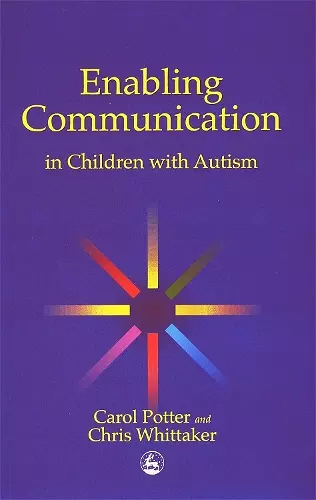Enabling Communication in Children with Autism
Carol Potter author Christopher Whittaker author
Format:Paperback
Publisher:Jessica Kingsley Publishers
Published:15th Mar '01
Currently unavailable, and unfortunately no date known when it will be back

Addresses the social and environmental issues effecting communication in children with Autism
Addressing the issue of what constitutes a communication enabling environment for children with autism who use little or no speech, the authors show that the communication of these children can be significantly affected by a range of social and environmental influences. This book provides an overview of the theoretical issues and practical advice.
Addressing the complex issue of what constitutes a communication enabling environment for children with autism who use little or no speech, Potter and Whittaker show that the communication of these children can be significantly affected by a range of social and environmental influences. As well as providing an overview of the theoretical issues involved, Enabling Communication in Children with Autism provides detailed practical advice. Key elements of the recommended approach include
* the use of minimal speech
* proximal communication
* the use of appropriate systems of communication including multipointing
* providing many and varied opportunities for communication.
Arguing that encouraging spontaneous communication should be viewed as a major educational goal for these children, Potter and Whittaker demonstrate that these children can and do communicate in enabling environments and provide practical, proven strategies for creating such environments.
This book discusses research into educational provision for children with autism who have minimal or no speech. The authors argue for a focus on the strengths of the child rather than a 'deficit model' of autism and for the creation of 'communication-enabling environments' with a view to encouraging spontaneous communication. I believe the book will be very appropriate to its target audience since it contains much practical advice, for example, concerning the provision of high quality communication opportunities and communication environments. It is a very readable and well-structured book, and readers are likely to appreciate the 'summary points' at the end of each chapter and the 'key research findings' sections. Interesting case studies are used throughout the book. A general strength of the book is that the approaches and strategies advocated are clearly grounded in research, so that the authors can provide 'clear evidence that they were enabling for the children'. A further strength lies in the authors' attempts to raise and address challenges that their strategies might pose to practice. -- Communication
This book is primarily aimed at professionals working with autistic children who use little or no speech. However, those working with older pupils and adults, as well as those with severe learning difficulties but without autism will find much that is useful. The discussion, advice and strategies here are useful for professionals involved in staff training and in providing whole school approaches to working with children with little or no speech. Useful chapters consider classroom management, deployment of staff and the prioritisation of communication in the curriculum and SCAA documentation-excellent advice for this complex area. The book is clear and accessible. The key research findings and actual scenarios are linked with the discussions and practical suggestions. Key points are summarised at each stage and there are helpful tables throughout the book. -- Bulletin
The authors of this book departed from previous approaches in that their focus was on spontaneous communication and the capacity of children with autism to initiate and approach others when presented with communication enabling environments. Apart from describing the research, the book has chapters on exactly what a minimum speech approach consists of with examples of how to use it. There is an excellent chapter on 'enabling styles of class-room management' which presents principles of good practice not only for class-rooms but for any service where there are individuals with significant learning difficulties. It is a book that I will be going back to and recommending to parents, teachers of young children, class-room assistants and speech and language therapists. -- The Frontline of Learning Disabilities
ISBN: 9781853029561
Dimensions: 232mm x 156mm x 12mm
Weight: 340g
208 pages